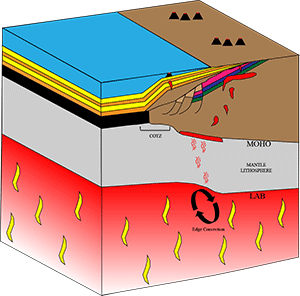Model #1: Edge Convection Model
 The edge convection model championed by Don Anderson and others as an alternative to plume theory has the potential explain, in part what mechanism initiated and resulted in the Cretaceous igneous activity seen in the Northern Gulf of Mexico. The model predicts, as shown in the associated diagram, that small scale convective scales in the upper mantle can cause magmatism in regions where crustal thickness varies, for example along the continent/ocean margins of the oceans worldwide. The initial perturbation that results in an instability within in the mantle is the impedance of flow by the thicker continental crust. This results in convection to occur on scale of approximately 20mm/yr.
The edge convection model championed by Don Anderson and others as an alternative to plume theory has the potential explain, in part what mechanism initiated and resulted in the Cretaceous igneous activity seen in the Northern Gulf of Mexico. The model predicts, as shown in the associated diagram, that small scale convective scales in the upper mantle can cause magmatism in regions where crustal thickness varies, for example along the continent/ocean margins of the oceans worldwide. The initial perturbation that results in an instability within in the mantle is the impedance of flow by the thicker continental crust. This results in convection to occur on scale of approximately 20mm/yr.
The main problem with this is the presence of the Magnet Cove carbonatite, and potential other undiscovered carbonatites in the subsurface. Such rocks are associated with mantle plumes, and are highly refractory in composition. The theory that linked carbonatites to recycled oceanic crust and limestone’s, to account for their > 50% volume carbonate mineral composition, has long since been disproved by isotopic testing. Though now one must revisit an assumption made since the beginning of the geological sciences. What is the nature of the upper mantle? Could there be refractory domain within the upper mantle that could source the unique rocks at Magnet Cove (see figure for conceptual model)? However, that being said edge convection does play a role in the Balcones Igneous Province, which developed nearly coeval to much of the rest of the igneous provenances in the Northern Gulf of Mexico during the Cretaceous.

